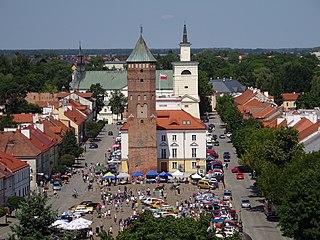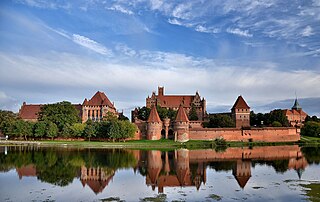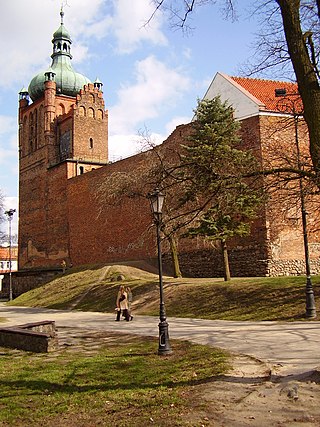
Elbląg is a city in the Warmian-Masurian Voivodeship, Poland, located in the eastern edge of the Żuławy region with 117,390 inhabitants, as of December 2021. It is the capital of Elbląg County.

Olsztyn is a city on the Łyna River in northern Poland. It is the capital of the Warmian-Masurian Voivodeship, and is a city with county rights. The population of the city was estimated at 169,793 residents in 2021.

Jawor is a town in south-western Poland with 22,890 inhabitants (2019). It is situated in the Lower Silesian Voivodeship. It is the seat of Jawor County, and lies approximately 61 kilometres (38 mi) west of the regional capital Wrocław. Through the town flows the 31 mile long Raging Nysa river

Warmian–Masurian Voivodeship, also known as Warmia–Masuria Province and Warmia–Mazury Province, is a voivodeship (province) in northeastern Poland. Its capital and largest city is Olsztyn. The voivodeship has an area of 24,192 km2 (9,341 sq mi) and in 2019 had a population of 1,425,967.

Bytów is a town in the Gdańsk Pomerania region of northern Poland with 16,730 inhabitants as of December 2021. It is the capital of Bytów County in the Pomeranian Voivodeship.

Brodnica is a town in northern Poland with 28,574 inhabitants as of 2014. It is the seat of Brodnica County in the Kuyavian-Pomeranian Voivodeship. The nearby Brodnica Landscape Park, a protected area, gets its name from Brodnica.

Ciechanów is a city in north-central Poland. From 1975 to 1998, it was the capital of the Ciechanów Voivodeship. Since 1999, it has been situated in the Masovian Voivodeship. As of December 2021, it has a population of 43,495.

Masovians, also spelled as Mazovians, and historically known as Masurians, is an ethnographic group of Polish people that originates from the region of Masovia, located mostly within borders of the Masovian Voivodeship, Poland. They speak the Masovian dialect of Polish.

Pułtusk is a town in northeast Poland, by the river Narew. Located 70 kilometres north of Warsaw in the Masovian Voivodeship, it has a population of 19,224 as of 2023. Known for its historic architecture and Europe's longest paved marketplace, it is a popular weekend destination for the residents of Warsaw.

Duchy of Masovia was a district principality and a fiefdom of the Kingdom of Poland, existing during the Middle Ages. The state was centered in Mazovia in the northeastern Kingdom of Poland, and during its existence, its capital was located in the Płock, Czersk and Warsaw. It was formed in 1138 from the territories of the Kingdom of Poland, following its fragmentation, that was started by the testament of Bolesław III Wrymouth. The country existed in the years: 1138–1275, 1294–1310, 1370–1381, and 1495–1526, between that time, going through fragmentations of its territory into smaller duchies and its unification. The states formed during its fragmentation were duchies of Kuyavia, Dobrzyń, Czersk, Płock, Warsaw, Rawa and Belz. In 1526, the country was incorporated into the Kingdom of Poland.

The Gothic architecture arrived in Poland in the first half of the 13th century with the arrival of the Dominican and Franciscan orders. The first elements of the new style are evident in the foundation of the Dominican Trinity church in Kraków (1226–1250), built by Bishop Iwo Odrowąż. Rebuilding of the Wrocław Cathedral, started in 1244, was another early manifestation of the Gothic style. The earliest building in Poland built entirely in the Gothic style is the chapel of St. Hedwig in Trzebnica (1268–1269), on the grounds of a Cistercian monastery.

The Castle of the Teutonic Order in Malbork, commonly known as Malbork Castle, is a 13th-century castle complex located in the town of Malbork, Poland. It is the largest castle in the world measured by land area and a UNESCO World Heritage Site.

Janusz III of Masovia, was a Polish prince member of the House of Piast in the Masovian branch. He was a Duke of Czersk, Warsaw, Liw, Zakroczym and Nur during 1503-1524 jointly with his brother, and sole ruler during 1524-1526 as the last male member of the Masovian Piasts.

The Bobolice Castle is a 14th-century royal castle in the village of Bobolice, Poland. The complex is located within a semi-mountainous highland region called the Polish Jura.

Czersk is a settlement in the administrative district of Gmina Góra Kalwaria, within Piaseczno County, Masovian Voivodeship, in east-central Poland. It lies approximately 2 kilometres (1 mi) south-east of Góra Kalwaria, 19 km (12 mi) south-east of Piaseczno, and 33 km (21 mi) south-east of Warsaw. The village also lies on the Czersk Lake, which is an oxbow lake of the Vistula.

Chełmno land is a part of the historical region of Pomerelia, located in central-northern Poland.

Castle of the Masovian Dukes is a Brick Gothic castle built at the turn of the 14th and 15th centuries. It is situated in the town of Ciechanów, Masovian Voivodeship, in Poland.

The Castle of the Masovian Dukes in Płock is a Gothic castle built under the reign of Casimir III the Great, becoming a stronghold of the Dukes of Masovia until the fifteenth century. The castle is located in the Princely Capital City of Płock, Masovian Voivodeship; in Poland.

The Olsztyn Castle, officially the Castle of Warmian Cathedral Chapter in Olsztyn, is a Brick Gothic castle located in the heart of Olsztyn, in northern Poland. Built in the 14th century, it served as the seat for administrators of property of the Warmian Cathedral Chapter. The most well-known administrator caretaker was Nicolaus Copernicus, a canon of Warmian Cathedral Chapter in Frombork, who resided here between 1516 and 1521. The largest expository room is the refectory with a diamond vault built around 1520. Currently, the castle houses the Museum of the Warmian-Masurian Voivodeship.

Coat of arms of the Duchy of Czersk is a legendary creature in folklore of Masovia in Poland, that is depicted as a Slavic dragon or wyvern. It was used in the coat of arms of the Masovian Piast dynasty, most notably in the coat of arms of the Duchy of Czersk and the Duchy of Warsaw, where it was depicted respectively as a green and red dragon with red tongue and claws.






















